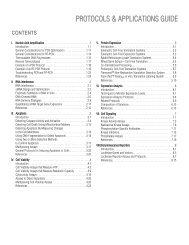2012 Promega catalogue
2012 Promega catalogue
2012 Promega catalogue
You also want an ePaper? Increase the reach of your titles
YUMPU automatically turns print PDFs into web optimized ePapers that Google loves.
Cell Signaling<br />
Tryptase, Human, Recombinant, β<br />
Product Size Cat.# Price ($)<br />
rhSkin β Tryptase 100 µg G7061 801.00<br />
rhLung β Tryptase 100 µg G5631 801.00<br />
For Research Use Only. Not for Use in Diagnostic Procedures.<br />
Description: Tryptase is the predominant protein in mast cell granules and<br />
cleaves proteins at arginine and lysine residues. Tryptase is stored and released<br />
from mast cell granules upon activation. Mast cells are found in many tissues<br />
but are present in greater numbers along epithelial linings of the body, such as<br />
the skin, respiratory tract and gastrointestinal tract, as well as the perivascular<br />
tissue surrounding blood vessels. They are involved in a variety of physiological<br />
and pathophysiological states, including immediate hypersensitivity, delayedtype<br />
hypersensitivity, cell growth regulation, defense against neoplasia, and<br />
pain and itch sensation. They have also been implicated in chronic<br />
inflammatory states and are involved in neuroimmune interactions. The<br />
availability of recombinant human tryptase will aid in research directed toward<br />
a more complete understanding of the biological role(s) of tryptase and mast<br />
cells and the identification of tryptase in vivo targets.<br />
Skin β I Tryptase, Human, Recombinant (rhSkin β Tryptase) and Lung β II<br />
Tryptase, Human, Recombinant (rhLung β Tryptase) are neutral serine<br />
proteases. The human β tryptase enzymes have been cloned and stably<br />
expressed in Pichia pastoris as fully active tetrameric enzymes and purified by<br />
affinity chromatography. The two enzymes differ in buffer formulation, enzyme<br />
concentration and glycosylation pattern. rhLung Tryptase is provided at a much<br />
higher concentration (2mg/ml) in minimal buffer without heparin for<br />
chromatographic studies and with glycosylation more closely resembling<br />
cadaveric enzyme as demonstrated by glycosidase digestion followed by<br />
Western analysis of the two recombinant enzymes and native lung tryptase.<br />
Specific Activity: Measured as the rate of hydrolysis of 0.4mM Nα<br />
CBZ-L-Lysine Thiobenzyl Ester as substrate coupled with Ellman’s Reagent<br />
(5,5´-Dithio-bis(5-Nitrobenzoic Acid)) in a final volume of 1ml, incubating for 1<br />
minute at 25°C, and monitoring the absorbance change at 410nm. One unit is<br />
defined as 1.0 absorbance unit change per minute.<br />
• rhSkin β Tryptase: >1,000 units/mg protein.<br />
• rhLung β Tryptase: >1,200 units/mg protein.<br />
Concentration:<br />
• rhSkin β Tryptase: 200μg/ml.<br />
• rhLung β Tryptase: 2mg/ml.<br />
Features:<br />
• High Specific Activity: Specific activity is consistently 130–150% higher<br />
than native lung tryptase.<br />
• Consistent: Recombinant protein expression results in uniform enzyme<br />
from batch to batch.<br />
• Safe: Void of human pathogens associated with native cadaveric tryptase.<br />
• Pure: Skin β and Lung β Tryptase are free of other contaminating proteases,<br />
providing more active enzyme per milligram of protein and eliminating<br />
extraneous protein interactions observed with native tryptase.<br />
Storage Conditions: Store at –20°C.<br />
For complete and up-to-date product information visit: www.promega.com/catalog<br />
undigested digested<br />
MW<br />
Native<br />
rhSkin<br />
rhLung<br />
Native<br />
rhSkin<br />
rhLung<br />
MW<br />
—34kDa<br />
—29kDa<br />
Glycosidase digestion of human β tryptase with PNGase F yields<br />
single tryptase core protein. Western blot with Anti-Human Tryptase mAb<br />
(clone AA5, Cat.# G3361).<br />
ADME Assays<br />
For additional information see page 20.<br />
Apoptosis<br />
For additional information see page 25.<br />
Cell Viability Assays<br />
For additional information see page 34.<br />
Cytotoxicity Assays<br />
For additional information see page 38.<br />
Glutathione Measurement<br />
For additional information see page 44.<br />
Histone Deacetylase Assays<br />
For additional information see page 52.<br />
Nuclear Receptor Pathway Tools<br />
For additional information see page 271.<br />
Protein Kinases and Kinase Assays<br />
For additional information see page 64.<br />
3521TA08_1A<br />
145<br />
6<br />
Drug Discovery<br />
Section<br />
Contents<br />
Table of<br />
Contents
















